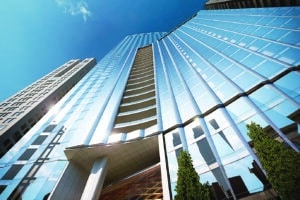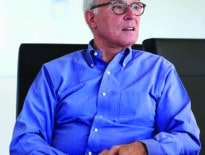
Millennium Partners’ 52-story Winthrop Center office and residential tower under construction at 115 Federal St. in Boston is slated to become the world’s largest Passive House office building. Image courtesy of Steelblue
People are increasingly concerned about how their immediate environs impact their health, with special attention to the indoor air quality of spaces we inhabit every day.
Concerns for personal health have also expanded into broader concerns about environmental health, with a global climate crisis evident in extreme weather and natural disasters of greater frequency and intensity. We have reached a critical inflection point in which wellness design and sustainability are not just trends to acknowledge, but responsibilities to embrace.
Handel Architects is enthusiastic about the bar being raised for the building sector to both increase human health and accelerate solutions to climate change. Over the last decade, we have developed expertise in the Passive House building standard, which is highly energy efficient, and provides a healthier and more comfortable environment for building occupants, with higher indoor air quality one of its core principles.
The Passive House Solution
Buildings account for nearly 40 percent of carbon emissions, and reducing this number is crucial for the planet. The world’s first Passive House, “Darmstadt House,” was built in Germany as part of an effort to build more sustainably and to reduce environmental impact. Developed by Dr. Wolfgang Feist of the Passive House Institute, the concept is born from the idea that buildings can be warmed from “passive” sources – such as the sun and heat emissions from appliances and building occupants – instead of relying on fossil fuels. Leveraging enhanced ventilation systems that control the intake of fresh air and recover the heat from outgoing air, the Passive House approach reduces the energy needed to operate a building and provides a pathway to achieving short and long-term net zero ambitions.
Multiple systems must work together for a building to achieve optimal levels of comfort and energy efficiency and meet the exacting Passive House building standard. These include a highly insulated building facade, an airtight building envelope, superior windows and an energy recovery ventilation system to create a comfortable interior climate free of drafts and cold spots. The ventilation system constantly pulls in fresh air and removes stale air, while recovering the energy in the climate-controlled air leaving the building.
Handel Architects’ experience focuses on the Passive House standard set by the Germany-based Passive House Institute, which was originally developed for single-family homes, but is now applied to a wide range of buildings in a range of climates. Our initial experience with Passive House was designing The House at Cornell Tech in New York City, the largest and tallest Passive House residential building in the world. We brought our expertise in the benefits of Passive House and how to apply it to Winthrop Center, which is slated to become the largest Passive House in the U.S. and the largest Passive House office building in the world.
Scheduled for completion in 2022, Winthrop Center is a 52-story mixed use tower comprising 812,000-square feet of office space and 321 luxury residences. The office tower section will attain WELL Building Standard Gold, LEED Platinum and Passive House certification. The project developer, Millennium Partners, envisioned a building whose impact would touch the larger Boston and global community by advancing personal health and well-being and becoming a market leader in sustainability.
Accelerating goals of carbon neutrality, the building sets a new standard for efficiency and comfort in a modern building and allows future tenants to feel good about working in a building that reduces energy consumption.
Dual Goals Advanced
Winthrop Center will use 65 percent less energy than the average office building in Boston and deliver 30-50 percent more fresh air than comparable buildings. A partnership with MIT professors led by the director of MIT’s Environmental Solutions Initiative, John Fernandez, highlighted the importance of delivering various environmental, physical and emotional health benefits through the built environment. Expansive space, great access to natural light (95 percent of working space is within 35 feet of a window) and private outdoor terraces on office floors are designed to promote occupant health and wellness. The project also considers the health benefits of inclusivity and community engagement, with a gathering space on the street level where the public and private meet, called “The Connector.” Yet the 2020 COVID-19 crisis period made one design element especially salient: superior indoor air quality.
While buildings have had to either rethink or quickly add safety, health and wellness-oriented features, including retrofitting their entire HVAC systems, Winthrop Center’s high-performance Passive House design and WELL Gold certification had already set the benchmark for the future, with high-efficiency ventilation and filtration mitigating the potential spread of COVID-19 and airborne pathogens. Winthrop Center replaces stale indoor air with outdoor air that passes through hospital grade filtration before being delivered to each office floor through Passive House energy recovery units.

Blake Middleton
We also employed a traditional glass curtainwall, enhanced with thermal isolators and triple-glazing, to minimize the risk of air leakage and ensure that only fresh air reaches office tenants. Additionally, Winthrop Center’s dedicated fan coil unit system makes ducted air available to individual zones with ducted return, so return air is not shared with others, thus reducing the risk of disease transmission associated with recirculated air.
Occupants will experience significantly higher air quality than they are accustomed to, and this will have positive implications for their health, overall happiness and productivity. A recent study by researchers at the Harvard T.H. Chan School of Public Health Center for Health and the Global Environment, SUNY Upstate Medical University and Syracuse University found that improved air quality from high-performing, green-certified buildings could greatly increase the cognitive function performance of workers.
As a number of U.S. cities and states are adopting ambitious carbon emissions reduction goals through ever more demanding building codes, Passive House is increasingly recognized as the design standard of the future for its myriad benefits. By investing in energy efficient buildings that create healthier indoor environments, building owners and managers can support and advance the happiness and health of building occupants, improve tenant/employee satisfaction within buildings, and improve financial benefits due to greater occupant productivity.
Blake Middleton is a partner at Handel Architects.





